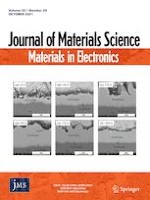09.09.2021
Synthesis of activated carbon from black liquor for the application of supercapacitor
Erschienen in: Journal of Materials Science: Materials in Electronics | Ausgabe 20/2021
EinloggenAktivieren Sie unsere intelligente Suche, um passende Fachinhalte oder Patente zu finden.
Wählen Sie Textabschnitte aus um mit Künstlicher Intelligenz passenden Patente zu finden. powered by
Markieren Sie Textabschnitte, um KI-gestützt weitere passende Inhalte zu finden. powered by
